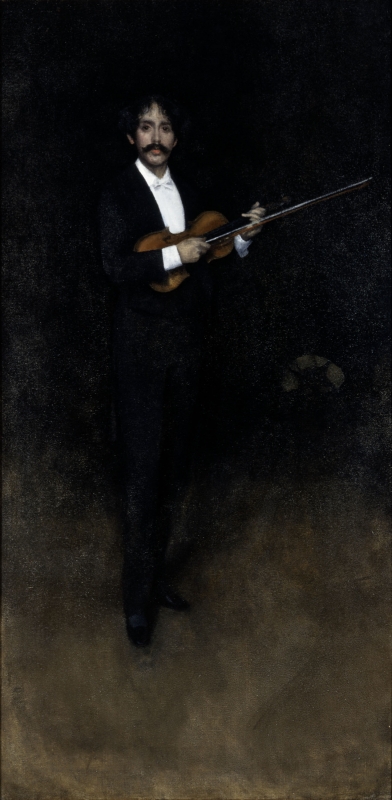Home > Catalogue > People > Charles Sprague Pearce (related works) > Catalogue entry
Arrangement in Black: Portrait of Señor Pablo de Sarasate dates from 1884. 1
The photograph of Pablo de Sarasate y Navascues (1844-1908), reproduced above, was signed and dated 'Au cher Maître Whistler, son ami et modèle Pablo de Sarasate, London, 84.' In a letter to Sarasate in that year, Whistler wrote:
'Dear Maestro -
We have been to hear you and see you - I thought you were simply splendid! -
If my portrait gives an impression of your appearance as a great Artist I shall be proud of my work.' 2
The portrait was described in the St James's Gazette on 7 July 1884 as 'just completed'. It was seen on 13 July 1884 by Joseph Pennell (1860-1926) 'in the studio, looming up at the end of a dark passage which led to it, looking just as Whistler wanted it to look, as if the violinist was standing on the darkened stage.' 3 According to the artist Walter Richard Sickert (1860-1942), he saw Whistler at work on the portrait, and when he took Albert Ludovici, Jr (1852-1932) to Whistler's studio, the portrait of Sarasate was on the easel. 4 Whistler also showed the portrait to another artist, Sidney Starr (1857-1925):
'In the Tite Street studio Whistler closed the large door and used a narrow one, three steps up to it. Leaving this door open, he would go down the steps and stand in the passage to look at his work. Through the door, the light coming from the large window on the left, one saw the tall canvas. The portrait finished, one forgot the canvas and became conscious only of M. Duret [Arrangement en couleur chair et noir: Portrait de Théodore Duret [YMSM 252]], Sarasate, or Rose Corder [Arrangement in Brown and Black: Portrait of Miss Rosa Corder [YMSM 203]] in the late afternoon light. I remember one afternoon he ... led me by the arm to the foot of the steps, saying, "There he is, eh? Isn't that it, eh? All balanced by the bow, you know. See how he stands!" It was Sarasate. And when the portrait was exhibited Whistler said, "They talk about my painting Sarasate standing in a coal cellar, and stupidities like that. I only know that he looked just as he does in my picture when I saw him play in St. James's Hall." ' 5
It was first exhibited at The sixty-second Annual Exhibition, Society of British Artists, London, 1885 (cat. no. 350). Whistler had it photographed and sent prints to friends including Auguste Rodin (1840-1817). 6 An engraving was made for the Magazine of Art in 1885. 7
In November 1895 Whistler expressed the desire to 'touch up' the portrait, but it is not known whether Whistler carried out his intention. 8
Notes:
1: YMSM 1980 [more] (cat. no. 315).
2: [March/July 1884], GUW #08133.
3: Pennell 1921C [more] , pp. 4-5.
4: Sickert, Walter, ‘Where Paul and I differ’, Art News, No. 14, 10 February 1910, p. 113.
5: Starr 1908 [more] . Pennell 1908 [more] , vol. 2, pp. 3-4.
7: Anon., 'Current Art IV,' The Magazine of Art, vol. 8, 1885, pp. 464-70, repr. p. 469.
Last updated: 18th December 2020 by Margaret







